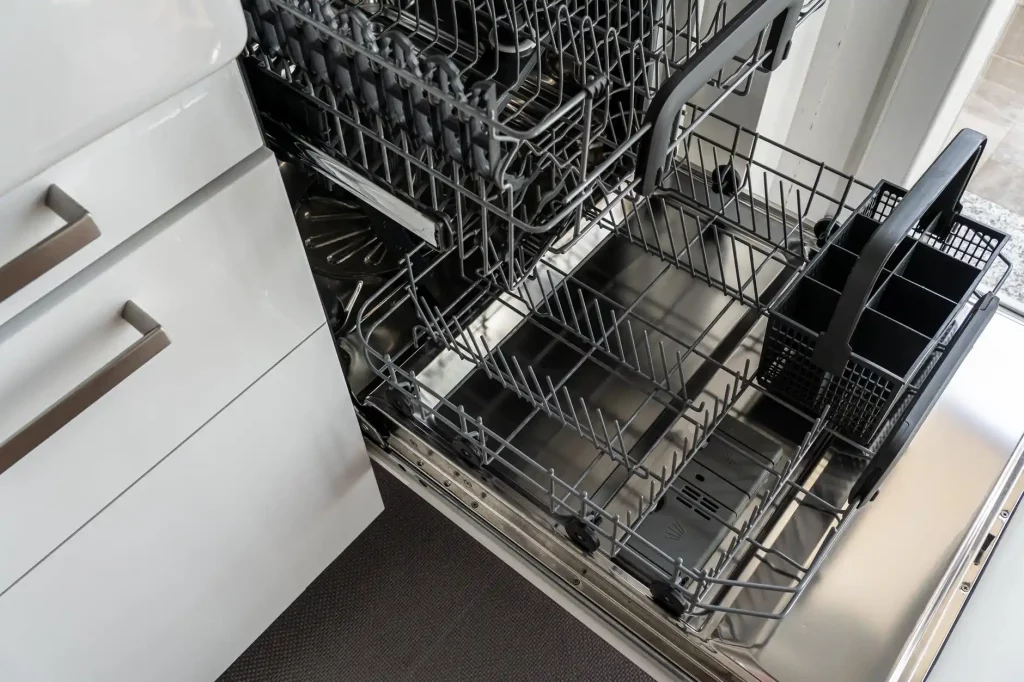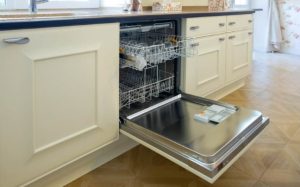
You might believe that the only issue with your Samsung dishwasher is that it starts up and runs through the selected cycle without any problems. However, if your dishwasher won’t drain, this can result in serious problems that need to be fixed right away.
If your Samsung dishwasher won’t drain, clear out any obstructions in your sink, look to see if the drain hose has been pinched, look inside the appliance for any leaks, pay attention to any indicator lights that might point to the issue’s cause, and try resetting the dishwasher.
Every Samsung dishwasher owner wants a machine that can easily disperse dishwashing soap, reach the proper temperatures to effectively clean tough grime, and generate enough water pressure to quickly wash away breakfast, lunch, and dinner.
However, after doing all of this, the residue drains out and settles at the bottom of your dishwasher.
If your Samsung dishwasher won’t drain, keep reading to learn how to solve the issue.

Dishwasher from Samsung Does Not Drain
As a step that naturally follows the appliance’s most crucial functions, the draining feature of dishwashers is not frequently considered.
But if you don’t drain, you end up with a pool of soiled food water that eventually stagnates, smells, and needs to be removed.
Read the information below if your Samsung dishwasher isn’t draining to find out what might be the problem and what you can do to fix it.
Make sure your sink is not the source of the issue if your Samsung dishwasher won’t drain.
If you have a garbage disposal, be sure to use it to check for any debris in the area and to make sure that water can flow freely down the drain without being obstructed.
Get a flashlight and look down the drain with it if you don’t have a garbage disposal to see if there are any obstructions. Use an unblocking agent or a tool that can remove the buildup or objects to unclog your drain if you notice that it is blocked in any way.
Once this is complete, start your dishwasher again to see if it will drain on its own before running hot water down the drain to make sure it can flow down easily.
Error Messages
The error codes 5C, 5E, OE, and OC all point to draining problems with Samsung dishwashers.
A drainage problem is also indicated by a pair of blinking lights, such as the Heavy and Auto or Heavy and Quick buttons.
For additional combinations that apply to your model, look up Samsung blinking light error codes.
Verify that the dishwasher is the problem.
- Make sure the dishwasher’s connected sink drains by running water through it.
- Make sure the garbage disposal is not clogged if the dishwasher is connected to one.
- Check to see if the garbage disposal knockout plug in the drain tube of the garbage disposal has been removed if the dishwasher was just installed.
Verify the Sink’s Connection to the Dishwasher
To use a dishwasher, the drain hose must be either attached to an air gap or have a high loop.
These features are in charge of preventing dishwasher wastewater from entering the dishwasher.
Typically, the air gap is a fitting attached to the kitchen cabinet or sink.
It functions by injecting air into the hose, which removes the potential for the discharged wastewater to return to the dishwasher under conditions of low pressure.
The drain hose is looped in the “high loop” technique so that it is fastened directly beneath the sink.
The dishwasher may have trouble draining if the air gap is blocked or the drain hose does not have a high loop. By taking off the cover and cap, the air gap can be examined and cleaned of debris.
Clean the tub, sump, drain hose, and filter.
Your Samsung dishwasher might have a removable filter depending on the model. You might be able to unclog the drain pump by removing the filter in addition to the filter itself.
For instructions on removing the filter, refer to the dishwasher’s manual.
If your model has a screw-accessible filter assembly or pump cover, removing the screws and cleaning the filter and pump assembly may fix the drainage problem.
To protect the motor and pump seals, the filter or pump cover should be replaced if it has been damaged.
Before gaining access to the filter and pump assembly, turn off the water and electricity to the dishwasher for safety.
Using a dishwasher washing powder or, in the potential substitute, white vinegar will dissolve food particles and minerals that have accumulated and may be preventing the dishwasher from draining if the dishwasher is not draining because of a blockage.
If you’re using white vinegar, pour one to two cups into a bowl that can go in the dishwasher and set it on the top dish rack. Next, shut the door and perform a routine cycle.
Examine the drain pump.
If none of the aforementioned fixes worked, the dishwasher’s drain pump should be examined for problems. Pump motor malfunctions can be mechanical or electrical.
A broken impeller is typically the root of a mechanical issue. It will be necessary to replace the impeller if it is damaged. A difficult to rotate impeller is a sign that the pump is broken. Check the impeller for any obstructions that might be causing it to malfunction.
To determine whether the drain pump has electrically failed, a multimeter can be used to check for continuity.
A continuity test will reveal whether the pump needs to be replaced or not. Most functional drain pumps should register a resistance reading of about 200 ohms when tested.
The drain pump can either be reached by removing the bottom front kick plate or by turning the dishwasher on its back and removing the access panel underneath the dishwasher, depending on the model.
Check the Check Valve
Once wastewater has been pumped out of the dishwasher, a check valve prevents it from coming back in.
The water will not drain properly if the check valve becomes stuck shut.
The issue might be resolved by cleaning the check valve, but if it still exists, you should replace it.
The check valve is found on the drain pump or pump housing’s outlet port.
To inspect it, you must take off the kick plate or bottom access panel.
Verify the flapper’s freedom of movement and the absence of any wear or damage signs.




